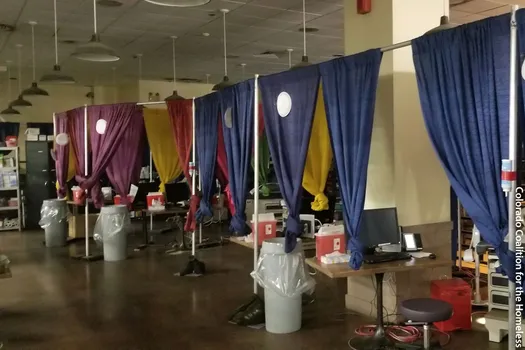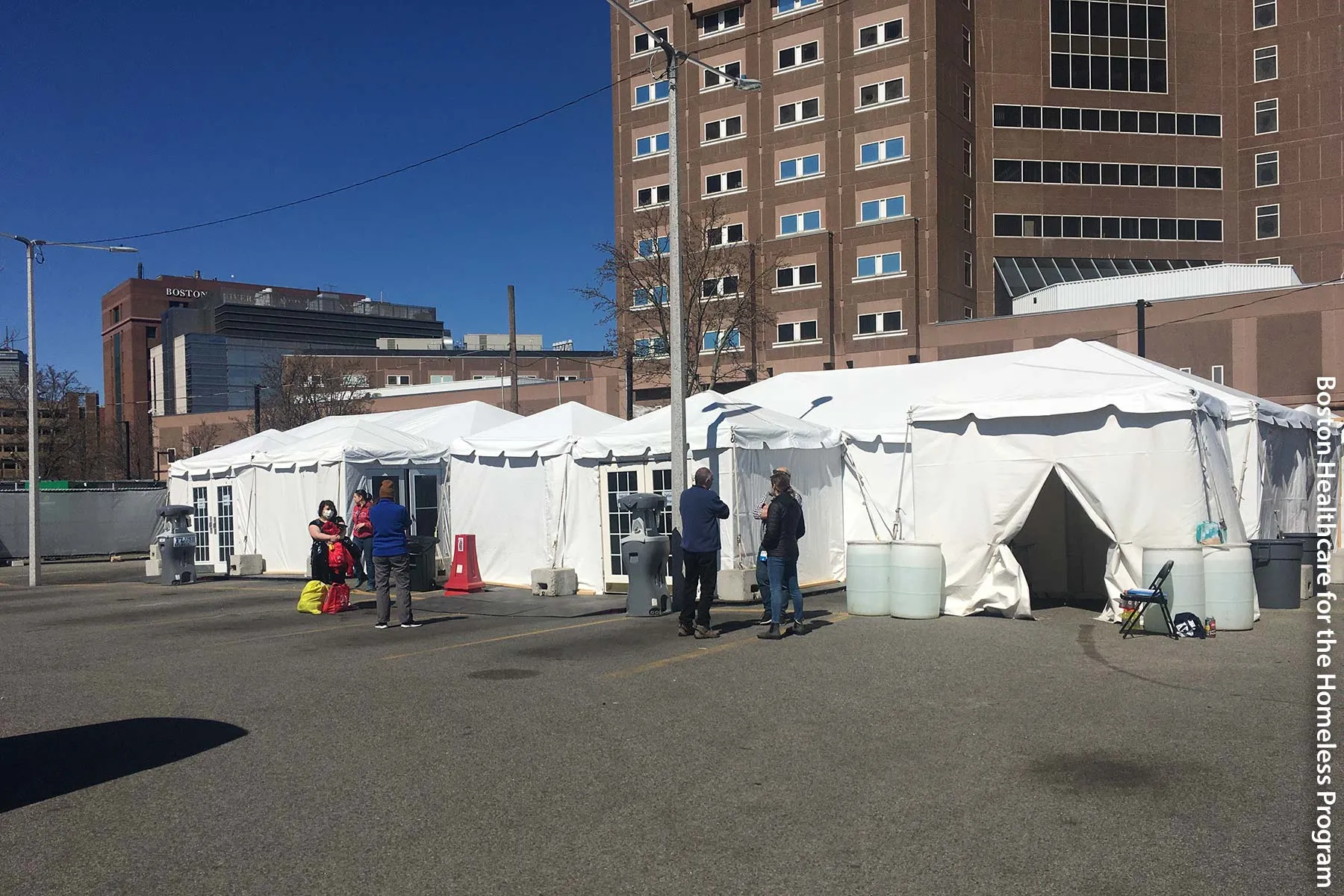
Facing COVID Without a Home, Without Health Care
by Lisa MarshallMay 29, 2020 --It’s morning at the National Western Complex in Denver, and a line has begun to form at the front door. Weary-looking men wander up slowly, some from nearby tent encampments, others via a white school bus shuttling them in from an overcrowded shelter.
Toting overstuffed backpacks or tattered blankets draped around their shoulders, they wash their hands, have their temperature taken–as is required–and answer some questions: Have you had a cough, sore throat, or fever recently? Nearby, in a makeshift triage tent, two nurses wait with nasal swabs, testing anyone symptomatic for the novel coronavirus before sweeping them off to a hotel room to quarantine as they await results.
The others shuffle inside, not to attend the stock show or rodeo–as this sprawling 600,000-square-foot venue is best known for–but to take shelter from a deadly pandemic. As many as 740 men will sleep in the exhibit hall tonight, on cots 6 feet apart.
“It’s dangerous and scary enough for us just living on the streets,” says James Townsend, who at 60 and African American is particularly vulnerable to complications if he gets the virus. “I wish it would just go away.”
Townsend is among the 575,000 U.S. adults who are homeless on any given night–a status that, even before the pandemic, put them at higher odds of a host of medical problems. For them, the coronavirus has been catastrophic, ripping through overcrowded shelters where as many as two-thirds of residents–many of them elderly and with weakened immune systems–tested positive in early spring.
Cash-strapped nonprofits nationwide swiftly appealed to government agencies for help, and almost overnight did what just a few weeks earlier would have seemed unimaginable: They transformed sports arenas and convention centers into spaces where the unhoused could spread out and clean up, rented hotel rooms to quarantine COVID-positive individuals, and provided port-o-potties, hand-washing stations, tents, and even RVs for people living in encampments on the street.
As awful as it has been, there are lessons to be learned here, say advocates for the homeless.
“As a result of this pandemic, we are starting to have more and more people get involved and say, ‘How do we solve homelessness?’” says Barbara DiPietro, senior director of policy for the National Health Care for the Homeless Council. “How do we use this as an opportunity?”
Public Health Guidelines Impossible to Follow
Homelessness in general is hard on health. The unhoused are more likely to suffer from substance use disorders, heart disease, lung, liver and kidney disease, and HIV; and the chronic stress of living on the streets can age the body prematurely, making a 45-year-old look more like a 60-year-old medically.
A homeless individual was already between 4.5 and nine times more likely to die between the ages of 25 and 65 than age-matched counterparts with a roof over their head.
Then the coronavirus happened.

With restaurants and food banks closed, dumpsters empty, and no generous patrons to share their leftovers, many went hungry this spring. With public spaces like libraries and recreation centers shuttered, they had no place to use the bathroom or seek refuge from the heat or cold. And the advice the rest of us got to “stop the spread” was problematic at best.
“The state of being homeless is absolutely incompatible with the public health response to the pandemic,” says Cathy Alderman, vice president of public policy for the Colorado Coalition for the Homeless, during a tour of the Denver complex. “You can’t stay home if you don’t have one. You can’t wash your hands if you don’t have access to facilities, and you can’t social distance if you live in a crowded, congregate setting.”
Overcrowded shelters quickly became a tinderbox of infection, with one study of 19 shelters in four cities showing a quarter of patrons and one in 10 staffers were infected. In San Francisco, the numbers were even higher, with two-thirds of homeless people testing positive.
By the time the pandemic plays out, one study predicted, 21,000 homeless people would have been hospitalized and 3,400 would be dead. Also troubling, one study of 408 people tested in a Boston shelter this spring found that of the one-third who tested positive, 88.8% reported no symptoms at all.
“That’s good for that individual, but bad for public health,” says study author Travis Baggett, MD, an assistant professor of medicine at Harvard Medical School, noting that asymptomatic individuals unknowingly transmit the virus. “A communicable disease pandemic underscores the fact that we are all connected here. Our neighbor’s health is our health, and these are our neighbors too.”
Finding Ways to Deliver Medical Care
Alarmed by such numbers, nonprofits, health care providers, and city, county, and state emergency response teams began to form rare new alliances this spring.
In Boston, the city and the Commonwealth of Massachusetts teamed up with Boston Health Care for the Homeless Program to transform the glistening downtown convention center into a 500-bed field hospital for COVID-positive individuals with no homes.
There, a skeleton crew of doctors and nurses clad in full Tyvek suits, face shields, and double gloves roamed the grounds taking vital signs and transporting those with deteriorating health to the hospital. Meanwhile, those who were only mildly ill wandered freely, watching movies projected on a screen or joining a game of bingo or corn hole.
“We do our best to try to mimic an environment we would want to be in if we were told we had coronavirus and we had to stay home,” says Bridget Sullivan, director of nursing at the Boston Hope field hospital, during a May interview. “We are this odd little community all in here together–us in PPE [personal protective equipment], them without it–fighting coronavirus.”
The pandemic did not put a halt to the myriad other medical needs of the unhoused.
Inside the Denver complex, volunteers swiftly transformed the National Western Bar and Grill Steakhouse into a makeshift clinic, purple curtains delineating 11 exam rooms. There, amid the neon Coors signs, bar stools, and posters of bucking broncos, visitors came throughout the day to have a sore tooth or broken arm tended to, meet with an addiction counselor, or get an overdue checkup.
At the Cattleman’s Grill, the vendor that typically cooks for hungry stock show goers instead served up three hot meals a day.
Next door, at the massive concert venue, the Denver Coliseum, homeless women slept in a similar complex, some catching a ride on a golf cart to go visit their male partners.
Elsewhere downtown, in hundreds of vacant hotel rooms leased by the city of Denver, elderly and immune-weakened men and women hunkered down alone, trying not to get infected.
“A lot of people get into these spaces and take a shower for the first time in years or lie down on their bed and sleep for hours because they have been on the ground for so long. They get their dignity back,” Alderman says, noting that these experiences, combined with much-needed health care can serve as a bridge to get people into permanent housing. “When this all tapers off, I don’t know how we are going to tell all these people they no longer have a place to be.”
If the pandemic has taught us anything, she and other advocates for the homeless say, it is that we must do more to make housing affordable, as good health and a home go hand-in-hand.
“The reason we have to do all these crazy things is because there is such widespread homelessness in this country in the first place,” Baggett says. “We need to start thinking about permanent solutions. Or else when the next coronavirus comes around, we’ll be doing this all over again.”
Sources
Cathy Alderman, vice president of communications and public policy, Colorado Coalition for the Homeless, Denver, Colorado.
Boston University: “Estimated Emergency and Observational/Quarantine capacity Need for the U.S. Homeless Population Related to COViD-19 Exposure by County.”
Barbara DiPietro, senior director of policy, National Healthcare for the Homeless Council, Nashville, TN.
JAMA Internal Medicine, “Mortality among homeless adults in Boston,”
CDC Morbidity and Mortality Weekly Report: “Assessment of SaRS-CoV-2 Infection Prevalence in homeless shelters – four U.S. cities, March 27 – April 15, 2020.”
Travis Baggett, MD, assistant professor of medicine,Harvard Medical Schoo, staff physician,Boston Healthcare for the Homeless.
Bridget Sullivan, director of nursing, Boston Hope Medical Respite Shelter.